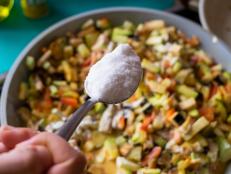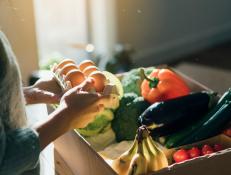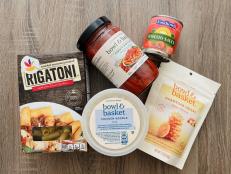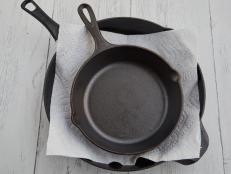Meal Prep Is Hard. Here's What Food Network Recipe Developers Do to Make it Easier.
Let's just say we've learned a thing or two while regularly staring down a to-do list filled with recipes.
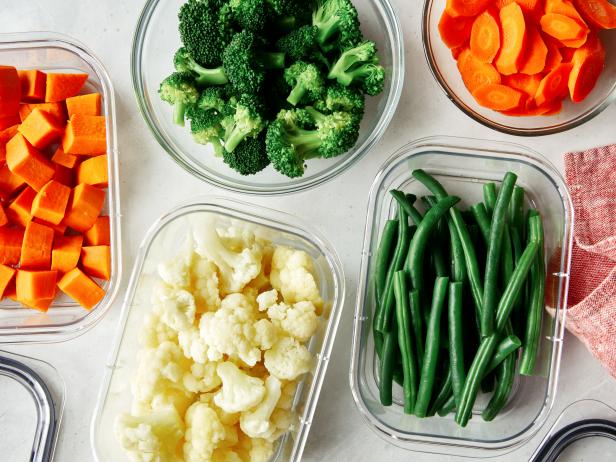
Teri Lyn Fisher
Get the Recipe: Meal Prep Steamed Vegetables
The thought of peeling garlic and chopping onions at 7:00 pm on a weekday is particularly unpleasant. And we at the Food Network understand that meal prep after a long day can be an unwelcomed and daunting task. That’s why we asked our recipe developers and stylists for tips and tricks to make meal prep easier throughout the week. These meal prep pros make multiple meals a day — whether it’s for work or just for their families at home — so rest assured that their strategies are tried and true!
Prep Some Low-Lift (But Workhorse) Items on Sunday
At the beginning of the week, I’ll boil a batch of eggs (I like them at 8 minutes) for a quick breakfast or snack or to use as protein in a salad. I also clean salad greens, make a grain (usually bulgur or quinoa because they are fast) and roast a couple of types of vegetables to make grain bowls. I'll add a protein — sometimes just a deli meat — or grilled chicken, shrimp or salmon that I also make ahead.
--Amy Stevenson, Recipe Developer
Wash Everything at Once
If I'm washing a head of lettuce, I chop, wash, and dry the whole thing even if I don't need it. Then I wrap the leftovers in a towel and package them in a container or resealable bag with some air in it. This way I always have lettuce ready to go.
--Alexis Pisciotta, Purchasing and Events Manager
Cube and Roast Veggies in Advance
My meal prep go-to is cubing up vegetables and roasting them before the week starts. I generally buy something in season, cut it so it is bite-sized, and add a little olive oil and whatever seasoning I am craving for the week. I then roast it until it still has some bite. I find that my vegetables are less likely to go bad when I do this, and it's more efficient timewise to prep one day and then reheat the rest.
I also find that having vegetables that I can pop in the microwave means that I add them to more meals. Salads and dinners are a given, but these days I am also adding a couple of veg bites to my eggs in the morning. This strategy is keeping me from throwing away food, it is saving me time day-to-day and making it easier for me to eat more vegetables.
--Larisa Alvarez, Executive Culinary Producer
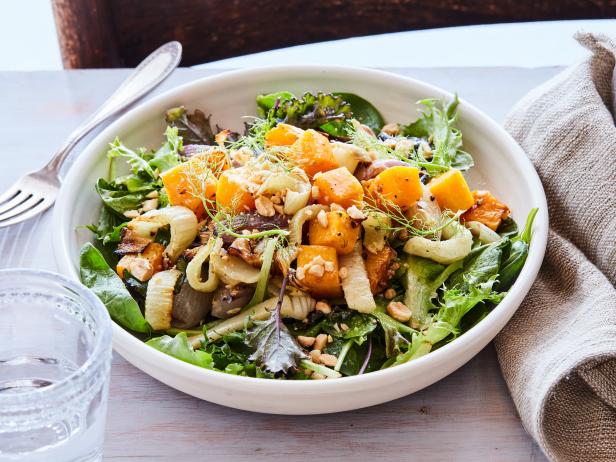
Matt
Get the recipe: Air Fryer Butternut Squash, Fennel and Shallot Salad
The Air Fryer is Your Friend
I've discovered that air-frying vegetables is the way to go: I cook batches of broccoli and cauliflower tossed in oil and salt (mushrooms are nice too) until tender and crispy brown. Then I add them to pasta or put them out as a filling option on taco night. They're also great to snack on and my son even tolerates a few florets packed in his lunch box.
--Leah Brickley, Senior Editor, Culinary
Don’t Shy From Pre-Made Ingredients to Save Time
Combining nutritious store-bought ingredients with other homemade components can make meal prepping much easier. For example, you can purchase a rotisserie chicken, and then prepare a whole grain and a vegetable, like brown rice and roasted broccoli. Not only will you spend less time meal prepping, you'll have a well-balanced meal to enjoy throughout the week.
--Amanda Neal, Recipe Developer
Use Condiments to Level Up Your Prepped Ingredients Fast
Have a few condiments on hand to add to dishes to jazz them up. I'm a big fan of adding tomato achaar to omelets or a pita sandwich filled with veggies and yogurt. Or a little chile crisp to some soba noodles with pre-seasoned tofu. Having some flavor-bomb condiments can give life to everyday dry pantry goods.
--Michelle Warner, Food Stylist
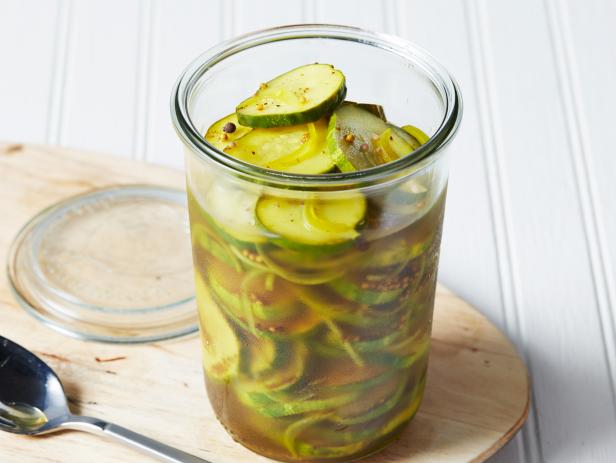
Armando Rafael
Get the Recipe: Quick Bread-and-Butter Pickles
Get Pickling!
I like to make a big jar of quick pickled veggies — carrots, cucumbers, red onion, baby bell peppers or radishes — that I keep in my fridge and last a week or two. They're a nice addition on top of a grain or noodle bowl, a salad or in a sandwich. I do a simple formula of 1 cup vinegar, 1 cup water, 3 tablespoons sugar, 1 tablespoon salt and a handful of whatever whole dry spices sound good to me at the time — fennel, coriander, cumin, mustard, peppercorns, etc. I bring the liquid to a boil and pour over the veggies in a jar. I let it cool and cover the jar and refrigerate to use throughout the week.
--Amy Stevenson, Recipe Developer
Make Big Batch Sauces
If I have a lot of herbs, I'll make a big batch of salsa verde or pesto. They keep longer than you think in the refrigerator if you cover them with a hearty layer of oil and store them in an airtight container. Then, everything else can be cooked really simply, because you have these big flavorful sauces to douse them with.
--Alexis Pisciotta, Purchasing and Events Manager
Use Frozen Veggies — and Don’t Bother Defrosting
There are only so many fresh veggies I can keep on hand at a time, but grabbing a bag of frozen chopped greens like spinach, kale or collard greens cuts down on prep time and ensures I always have something on hand to add to pasta, rice, or bean dishes. I prefer buying frozen vegetables in a bag versus a frozen square brick because I can easily remove as much as I need and put the rest back for another time. I often don't even defrost them — a quick sauté will cook out any excess liquid and freshen the flavor.
--Melissa Gaman, Recipe Developer
Precook Your Pasta and Grains
Since I'm often in the kitchen cooking for work, I try to make the most of that time by boiling pasta or cooking rice to add to a meal later in the week. These are the items that feel like they take too long after a long day. So at dinner time, I can make a quick fried rice with spare veggies and frozen peas (I always have frozen peas), or warm some pasta and make a quick pan sauce (or even use jarred sauce).
--Michelle Warner, Food Stylist
The Anti-Meal Prep Plan
My meal prep tips are of the anti-meal prep variety. I joined a CSA for my vegetables so I don't have to think about shopping or decide what looks good or is in season. (That takes too much energy.) Then I decide what to make based on what needs to get used first. The tender lettuces get eaten first, then things like zucchini or pole beans, leaving the cabbages for last, or even the following week.
--Alexis Pisciotta, Purchasing and Events Manager
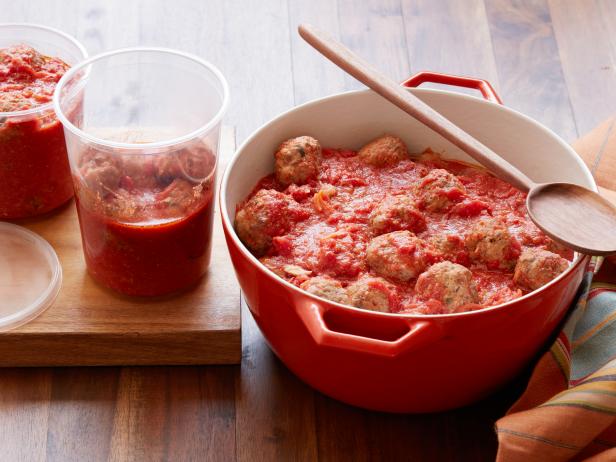
Matt Armendariz, Copyright 2015
Get the recipe: Big-Batch Meatballs
Freeze in Small Batches
When I cook in large batches, I freeze in small ones. I'll also buy proteins in small portions — especially seafood — and freeze them. They defrost quickly in a bowl of water and cook up quickly as well.
--Alexis Pisciotta, Purchasing and Events Manager
Master the Art of Mise en Place
At work in Food Network Kitchen and now at home, I like to start my day with everything already measured, chopped, and organized in containers or mixing bowls. For me, prep work — hunting and gathering, chopping, cleaning — is tedious and seems to stretch the process out of proportion. (Granted, I am definitely not a morning person, so that might be a factor….) So, I take some time out of desk work [the day before] to get that stuff out of the way. I love to come back the next morning to a clean kitchen, everything I need laid out on the counter or neatly stacked in the fridge. Add a cup of coffee and news or music, and I'm in a good space. It doesn't seem like much, but it makes both parts of the process seem shorter and cleaner. And smelling cake baking or beans simmering while I sit at my kitchen table is a nice thing, too.
--Miriam Garron, Senior Director, Fook Network Kitchen
Don’t Overthink!
I pick one day to do the week’s work. For novice meal preppers, I say start small and consider all the food groups — one protein, one veggie, and one starch/grain. Don’t overthink it past that. Once you compartmentalize your meal prep into these three, it will feel less daunting and more achievable.
--Matthew Skrincosky, Food Stylist
Related Links:

























